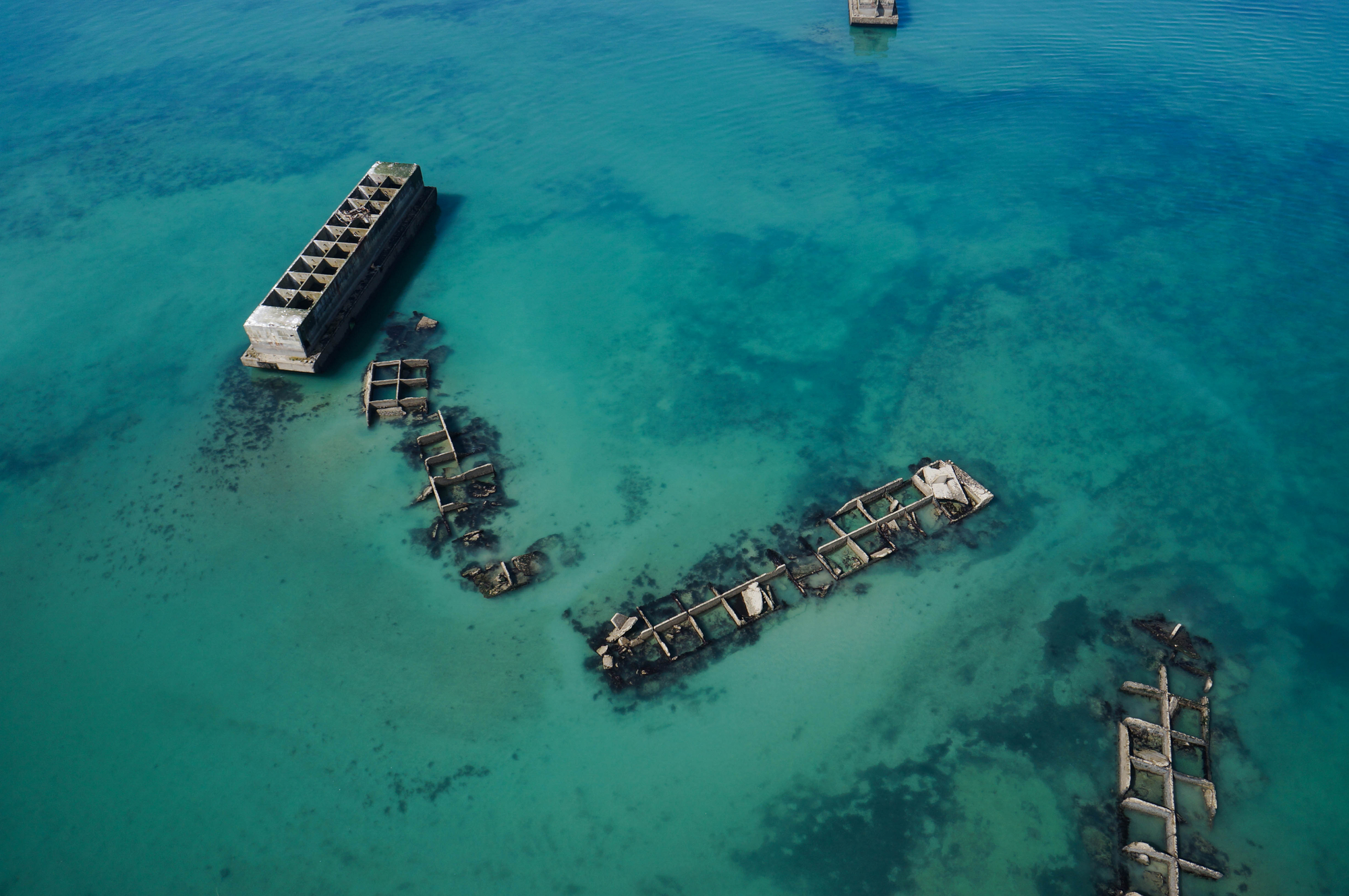
- Home
- A heritage destined to disappear
- The kings of salvage
Much of the destruction of the D-Day wrecks was due to metal salvaging. From the post-war period until the early 1990s, the French State granted companies the right to salvage metal wrecks found in the Baie de Seine.
The immediate post-war period
A question of safety and economics
The salvage of metal began in November 1944, primarily due to safety concerns. The aim was to clear the beaches and the Baie de Seine of wrecks that presented a danger to navigation and that hindered the resumption of maritime activities. The economic stakes were also substantial; given the constraints of the post-war period and reconstruction, metal objects and wrecks represented an important source of often rare and expensive metals (particularly bronze, brass and copper).
The Commission Locale des Renflouements de Cherbourg (Cherbourg’s local salvage commission)
Created on 8 November 1944, this commission was tasked with making a detailed inventory of the wrecks in the harbours of Cherbourg and Saint-Malo, around the Channel Islands and off the D-Day landing beaches. It was also charged with preventing looting. For example, on 28 February 1945, the commission provided surveillance for the former battleship Courbet, which was lying in shallow waters close to the coast, and which sparked a lot of interest. When re-floating the wreck was finally ruled out, a call for tenders went out on 21 June 1946 to have it scrapped. This project was entrusted to La Sirène, a company created by Mario Serra, a salvor of Italian origin who settled in France in 1935. He subsequently worked in Normandy until 1956, succeeded by his son, Gabriel Serra.
The multiplicity of property regimes for ships lost in the area complicated this task. Initially, the commission was only responsible for wrecks that had flown the French flag. It could not oppose decisions of the British Admiralty, which in April 1945 entrusted recovery of the blockships at Gold, Juno and Sword Beaches to the British Iron Steel Corporation. This company re-floated ten freighters, which were then scrapped in Scotland and Northern Ireland, and dismantled ten more deteriorated vessels on site. The company ceased activity in September 1949, presumably because it was operating without a contract, leaving behind some partially salvaged ships in the Gold Beach area.
A progressively regulated activity
The Société Nationale des Ventes de Surplus - SNVS (National surplus sales)
In August 1946, the French State decided to regulate metal salvaging by creating the SNVS. It was responsible for the sale of wrecks under French jurisdiction, as well as those abandoned by foreign owners in French territorial waters. Contracts and deeds of sale were signed with several, usually foreign, companies: the Belgian firm Van Loo at Omaha Beach, the Grignani brothers at Utah Beach, etc. The convention signed on 24 December 1948 between the French State and the Van Loo company, records the transfer to the latter of the American and British wrecks at Omaha Beach, in exchange for armour, weapons and a variety of spare parts.
In 1949, enormous demolition yards were set up along the coast and millions of tonnes of scrap metal were recovered from the sea over the following 20 years. These yards employed several hundred local workers, most of them rural. Some of the wrecks located in the Mulberry B harbour were sold at auction in May 1950. Following the closure of the company Lepage, one of its employees, Jean Demota, started his own firm at Courseulles-sur-Mer, and in 1955 the SNVS awarded it several wrecks located between Pointe de Tracy and Ouistreham. From 1960, the company, which employed up to seven professional divers, expanded the scope of its operations to the Utah and Omaha sectors, where it completed the unfinished work of the Grignani brothers and the Van Loo firm. In the 1970s, the young professional diver Jacques Lemonchois took over after the French State tasked him with the removal of the last troublesome wrecks. He subsequently founded the Musée des Épaves Sous-Marines du Débarquement (Museum of D-Day underwater wrecks), in Commes where his collection is now presented to the public.
The impact of metal salvaging on the wrecks
The current state of the D-Day wrecks closest to Normandy’s coast clearly reflects the impact of metal salvaging. Of the blockships that made up the five Gooseberries, generally only the hull bottoms remain. The wreck believed to be the Liberty ship Charles Morgan has also been clearly cut just a few centimetres above the seafloor. In contrast, reinforced concrete structures such as the Phoenix caissons of the artificial harbours and the blockships Vitruvius and David O’Saylor remain in good condition, as do the wrecks found further offshore.
Partners and authors
Associated media
Open Media Library

La Sirène employee cutting an armour plate from the Courbet

The officers’ mess on the Courbet at high tide

The salvage company La Sirène removing part of a D-Day wreck

The young Gabriel Serra on his first dive
On the Demota company’s pontoon in Courseulles

Removal of a cannon by the Demota company

Removal of an entire section of a wreck by the Demota company

Salvor Jean Demota and one of his divers

Claw crane, on the Lemonchois company’s BK pontoon
Multibeam echo sounder survey of a salvaged wreck

